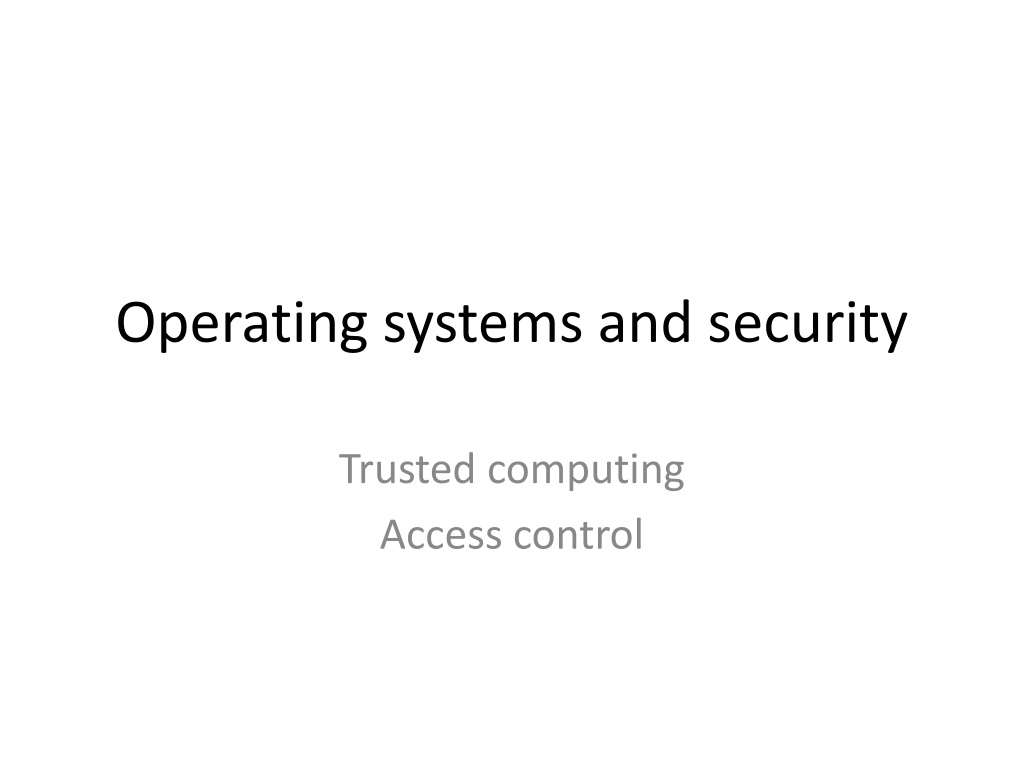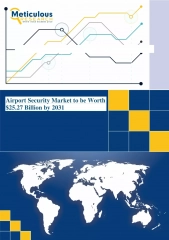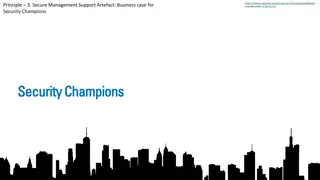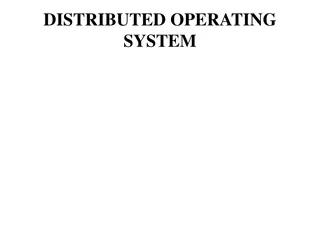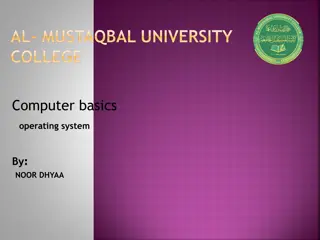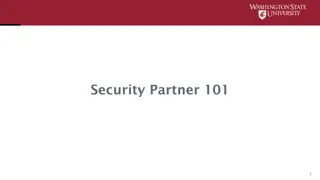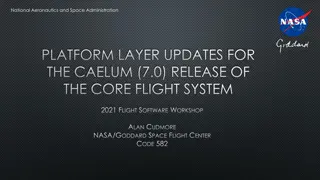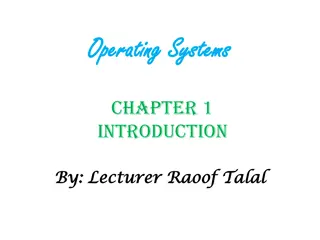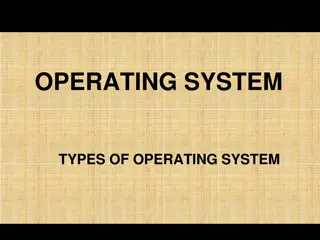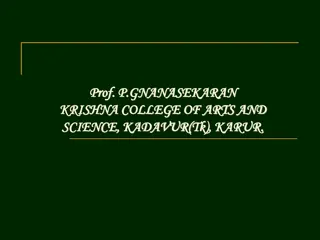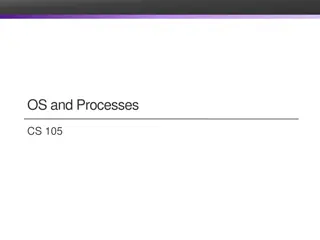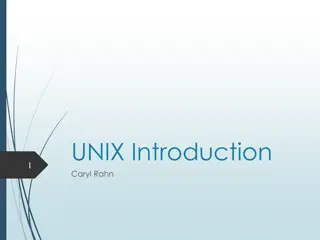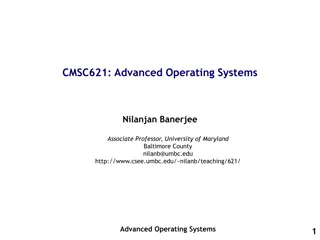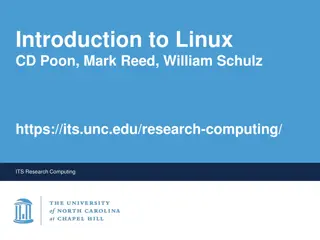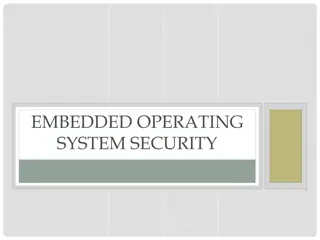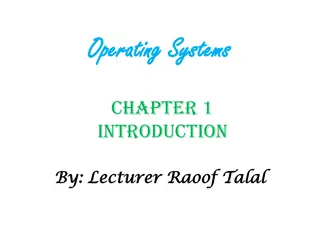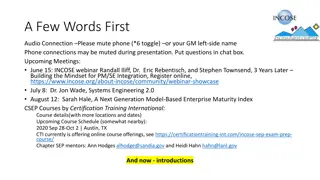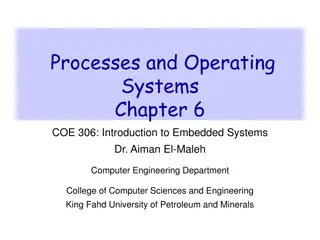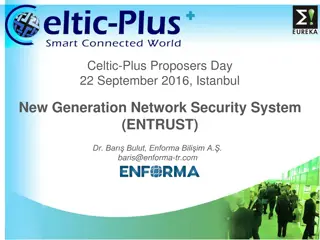Operating systems and security
This content delves into the key components and security aspects of operating systems, covering topics such as process security, hibernation vulnerabilities, file systems, virtual memory, and access control policies. It emphasizes the critical role of the OS in protecting user data and system integrity.
Download Presentation

Please find below an Image/Link to download the presentation.
The content on the website is provided AS IS for your information and personal use only. It may not be sold, licensed, or shared on other websites without obtaining consent from the author.If you encounter any issues during the download, it is possible that the publisher has removed the file from their server.
You are allowed to download the files provided on this website for personal or commercial use, subject to the condition that they are used lawfully. All files are the property of their respective owners.
The content on the website is provided AS IS for your information and personal use only. It may not be sold, licensed, or shared on other websites without obtaining consent from the author.
E N D
Presentation Transcript
Operating systems and security Trusted computing Access control
Operating system structure An OS is the interface between users and hardware Key components: Kernal, which runs various processes Device drivers API, which allows applications to communicate with the kernal Bios, which governs loading and startup
Process security The boot sequence is a key component of the OS, since initially all code is stored on harddrive The BIOS is stored on a firmware component, so automatic on startup From a security component, this is the most vulnerable stage Physical access means a user can tell the BIOS to load from a CD, at which point the attacker has full access Only real protection is a BIOS password
Hibernation Surprisingly, hibernation actually is a vulnerability also, for much the same reason. When a machine hibernates, entire contents (including any sensitive information) are stored to a file for quick recovery If an attacker can access the hiberfil.sys file, a forensic attack is quite possible Windows does not delete this file after resuming, so even a problem after rebooting
File systems One of the most important OS features governs access control, primarily of files Set differently in various OSes, although some commonalities
Virtual memory All architectures use some notion of virtual memory Key idea: each process can only see a portion of the computer s memory The memory management unit converts all requests automatically This actually adds quite a bit of security right away!
Access control Security policies govern both process and file system access Terminology: Subject Object Action Permissions Protections
Recap of access control Three main types of access control exit: DAC MAC RBAC We talked about (and are probably most familiar with) DAC, which is standard on most OSes. Want to examine the other two more carefully.
Mandatory Access Control Most MAC models are focuses on protecting information and classification levels. Inspired by government classifications: top secret, secret, unclassified. But might not be these! Just a set of levels MAC assumes a partially ordered set on levels: Think something like <=, but two things might not be comparable
Bell-La Padula Model Two rules: Simple security property: a user u can read an object o only if L(o) L(u) *-property: A user can write (edit/create) an object only if L(u) L(o) Essentially, this protects information from leaking down Note: communication is one way in this model
Biba Model Addresses integrity rather than confidentiality Reverses the rules from BLP: no read down, no write up Idea is that data at a higher level is more likely to be secure: Example: a data center is less likely to be compromised than a laptop
Clark-Wilson model Rather than security levels, this model deals with integrity in a system with transactions. Integrity constraints for the system that must be satisfied for the state to be valid. Certification methods that verify that transactions meet integrity constraints. Separation of duty so that a user cannot both execute a transaction and certify it. Primary use is in something like banking.
Chinese Wall model The Brewer and Nash (or Chinese wall) model is used to eliminate conflicts of interest among classes of data/groups.
Uses of MAC By themselves, we don t often see pure MAC Too rigid Difficult to make usable But more often, it is used in combination with DAC on modern operating systems And is still seen in specialized systems, where data confidentiality is the key concern
RBAC Role based access control defines role hierarchies and constraints. Roles can be inherited, with junior/senior relationships. Often roles are constrained, so that users cannot have conflicts of interest. Example: a grader shouldn t also be a student in a class. Can be dynamic or static in setup. Example: Windows security levels
Back to operating systems Normal operating systems must have: User authentication Memory protection File and I/O access control General object access control Enforcement of sharing and fairness guarantees A trusted OS builds upon these to give better security constraints
Trusted OS extra features MAC (in addition to DAC) Object re-use protection An attacker should not be able to gather information from resusable objects (such as disk memory) Complete mediation All objects access requests are checked each time (no caching) Audit capabilities Intruder detection capabilities
Secure OS Kernels The fundamental idea in a secure kernel is to specify a core set of OS functions. Small and carefully built Key idea: if the kernel is safe, things built on top of it will be better off.
Kernelization pros and cons Advantages: Smaller amount of trusted code Easier to check every access Separates this piece from more complex portions of the system Easier to maintain and modify security features Disadvantages: Introduces boundaries Temptation is to move as much as possible in (especially since inside tends to be faster and cheaper to work with)
Major challenge in kernalization Need to decide which functions are in or out. What must be trusted in order to ensure security for the rest of the system? Answer: depends on definition of secure Certain types of attacks are still possible against secure systems Those attacks were just left off of the definition
Layered OS design This concept essentially generalized that of kernelization. Define an inner layer with high security. Each next layer builds on that, with lower security options. Outer layers use the inner ones through a strong interface. Example: Multics Pre-UNIX (and arguably more sophisticated and powerful) Key element was layered security model Still considered one of the most sophisticated secure OS designs
Separation and Isolation Divide the system into components Define a secure interface for each, and allow communication ONLY over interfaces Goal: Ensure nothing bad crosses the boundaries The OS can separate based on either user or process boundaries, not just functionality Overall, extremely successful OS security approach.
Separation and Isolation: Examples This is the core idea behind virtual memory processes and how they are set up to run securely. Key elements of several more secure OS designs, such as such as domain and type enforcement in SELinux. Domain and Type Enforcement (DTE) allows the system to specify security domains for processes and security types for objects. Restrict types available to specific domains, and only allow access in specified ways Very successful in SELinux.
DTE Example Example: FTP daemon and buffer overflows Create FTP domain, and only FTP daemon and files in FTP directory can be executed in this domain. These executables may not be written within this domain. So what happens for a buffer overflow? The buffer overflow might allow the attacker to try to execute a program (say, /bin/sh). But the FTP daemon program was in the FTP domain /bin/sh is of a type not executable from this domain And so the buffer overflow can t fork a shell successfully
Example of DTE in SELinux Files in /etc are mostly limited to access by a few sysadmin process types But /etc also contains /etc/aliases, which the mail program must access (And everyone uses the mail program!) So rules are set up to allow the sendmail process type to access /etc/aliases Sendmail process: type sendmail_t The /etc/aliases file gets type etc_aliases_t
SELinux sendmail rule The following rules allows processes of sentmail_t type to access files of etc_aliases_t type for read and write without regard for which user started the process: allow sendmail_t etc_aliases_t:file { read write }; Permissions must be sufficient to allow normal work (read/write) but not too much to allow anyone to read and write everything in there.
Unix solution In contrast, in most linux distributions, sendmail is just set with setuid to a special user named mail (or something similar). Then /etc/aliases can be owned by mail user. Same result: any user can run the sendmail program, and sendmail can then access necessary data. So why is the SELinux approach better?
Unix versus SELinux approach Well, no need for fake users Central location for security-critical access control rules So no worries that a file somewhere may have incorrect permissions set. The sendmail process can now run under the identity of caller. In general, just a cleaner and nicer abstraction, although need to set up rules correctly.
Virtualization A technology that provides an abstraction of the resources used by some software which runs in a simulated environment called a virtual machine (VM) Simply run all untrusted things in a virtual machine, which can t access critical security elements. There are some security pros and cons here, though. (More in a few slides.) Can be used to run different OS applications, as well as tools such as Java.
Virtualization Alternatives application virtualization full virtualization allows applications written for one environment to execute on some other operating system virtual machine monitor (VMM) multiple full operating system instances execute in parallel coordinates access between each of the guests and the actual physical hardware resources hypervisor
Virtualization Issues Guest OS isolation Must ensure that programs executing within a guest OS may only access and use the resources allocated to it. Often, there are ways for the code to get out. Proper allocation of processes and resources. Put all related things in same VM? If not, must share data between them. Efficiency can be an issue.
Assurance and testing in the OS Testing: run a bunch of tests to see if it is secure. But what tests? When are we sure? Not really a strong proof of security, although it is the most used. Formal verification: define goals formally and mathematically Use formal methods to prove that system meetings goals. Often difficult to map real system to formal statements, and difficult to prove anything for real systems.
Validation Define desired security in terms of: Features provided Architectural design Processes used in creation of system Evaluation methodology Then use a standardized procedure to demonstrate that your system fits the profile of a level of security. Usually done against a pre-defined standard, which you can then label your system as.
Validation: pros and cons The good: Allows easy comparisons of systems. Easy to have security grades for systems. Relatively open and fair process. The bad: Doesn t actually really prove anything only as good as the standards set by the system. Can be expensive.
Secure OS standards There are national and international standards on what counts as a secure OS. We ve talked about SELinux here, but many types of secure OSes, since there is a market. Common ones: U.S. Orange Book European ITSEC U.S. Combined Federal Criteria Common Criteria for IT Security Evaluation
The Orange Book First evaluation standard developed by DoD in late 70 s. Now largely historical artifact, although terminology is still around. Levels A,B,C, and D, in decreasing order of security, with important subdivisions in each (1,2,3 ) Required formal certification from government for anything above the D level.
Orange Book classes C2 example: Windows NT DAC at fairly low granularity Access auditing Password authentication and protection of reused objects B1 example: PitBull variant of Solaris Includes MAC using Bell-La Padula model This is the highest classification that a standard OS with extra security added can get much harder to go higher.
Orange Book classes (cont) The B3 class (example: Trusted Mach) Requires more careful security design as well as some level of verification No formal verification, but needs a convincing argument Extensive testing required In general, the OS is designed with security in mind from the beginning. (In general, less user friendly and much more expensive.)
Failure of the Orange Book Expensive Didn t meet industry needs was focused more on military requirements, and so was fairly inflexible. Certified products were not marketed quickly. Wasn t clear that certification meant much. Windows NT was definitely not secure. Review was tied to the government.
The Common Criteria Current international standard (for many aspects of computer security, not just OS) Basics (with many TLAs): Evaluation Assurance Levels (EAL) Common Evaluation Methodology (CEM) Essentially gives a very detailed methodology for specifying: Security goals Operating environment Desired mechanisms Measures of success
The CC in practice You need a secure system, and so specify requirements using the CC methodology. Then you can look for products that meet these requirements or else develop one that does. Generally, independent labs then verify that the product meets the desired profile. In practice, a few are commonly used, and you generally select one that meets your needs from the list.
CC status Wide usage in many countries Including agreements in many places to honor other countries certifications Many products already certified Remaining issues: Still expensive and slow Unclear how meaningful certifications are Example: Windows 2000 was certified EAL4+ (in a range of 1-7), but needed a ton of patches and was not regarded as secure .
